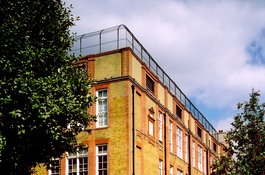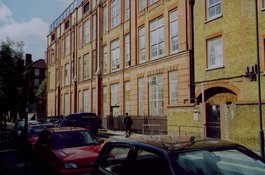Sugar Refineries, 12 Church St / 157 Hanbury St
Contributed by Bryan Mawer on Oct. 27, 2016
Prior to the school being built the site was used for sugar refining for much
of the 19th century. Horwood's early map c.1799 shows only four small
buildings, likely houses, at the east corner of Church St (later Hanbury St)
and Deal St. The later edition c.1812 shows a small sugarhouse to the east of
the site. The first occupants of 12 Church St appear to have been Blankenhagen
& Co 1804-5, followed by Herman Almeroth & Co through to 1813, and
then the Burnell family for many years. The original building, under the title
of Burnell, Geiss & Co, was destroyed by fire in 1821, but rebuilt and
considerably increased in size. By 1873 the refinery occupied an area from
Church St right back to Pelham St (later Woodseer St) and was run by James
Bryant and Thomas Burns Dakin. Church St was renamed Hanbury St, and
renumbered, in 1876. As 157 Hanbury St, Dakin ran it through to it's
closure in 1888. It was one of the last refineries to close in the East End.
It seems reasonable to assume that the original sugarhouse was purpose built.
Although small, it would probably have been four or five storeys high, in
brick, with small windows, and with loading doors towards the top. The later
building would have been maybe seven or eight storeys, in part at least.
Robert Montefiore Primary School, Deal St
Contributed by Bryan Mawer on Oct. 27, 2016
Quotation from Survey of London: Volume 27, Spitalfields and Mile End New
Town.
"This school was built for the London School Board. The contractors were
Messrs. A. Reed and Son of Stratford, whose tender for a school for 1,200
children was for £16,945. The architect was T. J. Bailey and the date of
opening was 10 February 1896. The building is three storeys high, built
of stock brick and hard vermilion brick with some Portland stone dressings,
the elevations being divided by pilasters into bays, each three windows wide.
The ground storey is rusticated above a plinth of purple engineering brick and
there is a moulded band at first-floor and roof levels. The playground on the
roof is screened by a high parapet with rectangular openings containing
decorative iron grilles. The thin crowning cornice carries stone vases. The
south front is five bays wide with a low wing to the east. The end bays are
treated differently, the eastern one being pedimented, with stucco ornament in
the tympanum. The north front is asymmetrical with a huge segmental bow near
the centre topped by a stone balustrade. To each side are dissimilar
pedimented wings."
The Montefiore Centre, Hanbury St
Contributed by Bryan Mawer on Oct. 27, 2016
The building continues its use as an establishment for education and training,
having been opened in 1896 as the Deal Street Elementary School and renamed
later as The Robert Montefiore School.
Being toilet paper monitor at Robert Montefiore School
Contributed by Sarah Milne, Survey of London on June 3, 2017
Rosemarie's memories of going to school at Robert Montefiore in 1960s:
I was toilet paper monitor when I reached the upper ages of the school. Toilet
paper was not in abundance at the school. We used Izal paper which not so many
people remember now. You were given the duty of standing outside the loos
(girls and boys) and giving two sheets of paper to each person who entered.
Only two sheets! You'd never do that now.
From three to a bed to a BSc
Contributed by Sally_Caplan on Oct. 31, 2018
My grandfather Samuel Rubein had a tailor's shop at 41 Hanbury Street and
lived with his wife and five children above the shop. The three boys could not
go to bed until their father had finished playing cards; they shared a bed. My
father used to garden on the flat roof; how this came about we do not know. He
did a part-time degree and graduated with a BSc going on to become a science
teacher a various schools in the area. In particular he taught at Robert
Montefiore. He and my mother also took a hundred Jewish children, evacuees, to
Constantine in Cornwall, where he worked at the local school and then
volunteered for the RAF. We have no details as to how he took the children but
his parents and in-laws also went. We would love to know more about his
involvement and how it came about.

